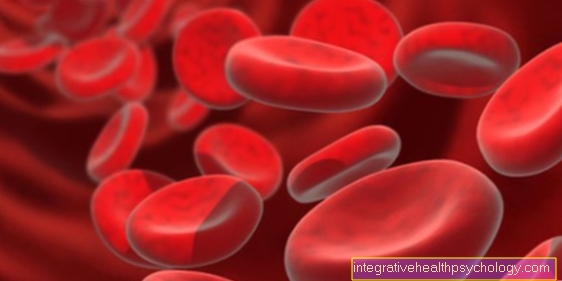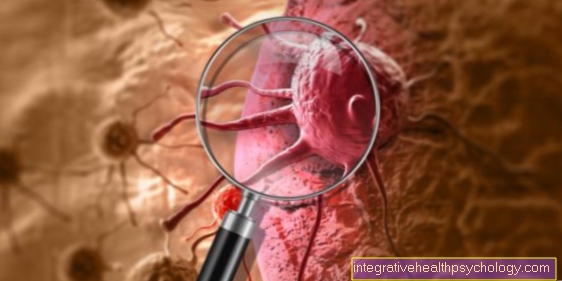Symptoms of pneumonia
What are the typical symptoms of pneumonia?
Both Pneumonia Symptoms one differentiates those that are by a typical pneumonia and which were triggered by a so-called atypical pneumonia were triggered.
Typical pneumonia:
Noticeable with the so-called typical pneumonia is the sudden onset the symptoms of the disease with chills and high fever. Furthermore, there is a severe malaise and poor general condition.

Patients with typical pneumonia also complain of mucous sputum (productive cough). This is often described as rusty yellow. In many cases, shortness of breath is also added to the symptoms.
Sometimes pneumonia is accompanied by a herpes infection (Herpes labialis on the lip).
Because of the frequent coughing, many patients also complain of lung pain or chest pain.
When listening to the lungs, so-called wet rattling noises, the X-ray shows light areas in the affected area (Shading) that for a Pulmonary infiltrate to be able to speak.
Read more on the topic: Chest x-ray (chest x-ray)
In the laboratory, the inflammation values are like of the CRP value or the Sedimentation rate elevated. That too Procalcitonin is high in bacterial infections.
After about a week, the fever will drop. This leads to increased cardiovascular stress.
The symptoms of pneumonia are not always limited to the lungs, but can cause other serious symptoms by spreading bacteria into the bloodstream. Read also: Consequences of pneumonia
Atypical pneumonia:
The onset of atypical pneumonia is slow and insidious. The body temperature is usually only slightly increased and there is usually no chills. Atypical pneumonia is accompanied not by slimy sputum but by dry, irritable cough with little sputum. The general well-being can also be severely impaired.
Furthermore, in many cases there is also shortness of breath and a drop in performance. When listening to the lungs, in many cases no moist rattling noises are noticeable, which makes the diagnosis very deceptive.
Shadows may or may not be seen in the X-ray.
In the laboratory, the inflammation values are often (CRP) is also increased, while the leukocytes are often in the normal range. In many cases the procalcitonin is not increased.
A classic defensive after a week is usually not so noticeable due to the low level of fever in atypical pneumonia.
Despite the sometimes slow and sometimes milder symptomatic form of atypical pneumonia, this type of pneumonia should not be underestimated, as it can quickly and surprisingly lead to a septic clinical picture (blood poisoning), which can mean a life-threatening condition for the patient.
The symptoms of pneumonia are not always limited to the lungs, but can cause other serious symptoms by spreading bacteria into the bloodstream.
Read also:
- Consequences of pneumonia
- Pneumonia
Pneumonia without a fever
A high temperature or fever is one of the characteristic symptoms of pneumonia.
However, inflammatory processes in the lung area can occur even without a fever. In such cases one speaks of a "Cold pneumonia". Since one of the most important symptoms of cold pneumonia is missing, the affected patients are often initially diagnosed with a flu-like infection. Cold pneumonia itself is recognized as such very late in many cases due to the similar symptoms.
Pneumonia that does not cause a fever usually shows up as:
- Body aches
- Chest pain
- Back pain
- Cough and
- general exhaustion
The intensity of these symptoms depends primarily on the age of the patient and the extent of the inflammatory processes. Pneumonia without a fever is, like classic pneumonia, contagious. (More on the subject: Pneumonia infection risk)
In most cases, a patient who does not have a fever with pneumonia can get viral agents (called Pneumococci) be detected. These viral pathogens, which are typical for pneumonia without fever, are transmitted to other people via droplet infection. In addition to pneumococci, bacterial pathogens can also be the cause of pneumonia without fever.
In a direct comparison between children and adults, it can be observed that pneumonia without a fever occurs much more frequently in small children and children. In addition, older people and people with impaired immune systems are at increased risk of developing pneumonia that does not cause a fever.If bacterial pathogens are responsible for the occurrence of pneumonia without a fever, treatment is usually carried out by giving an antibiotic. Viral pneumonia that does not cause a fever, on the other hand, must be treated purely symptomatically. Affected patients should always ensure that they drink sufficient amounts of fluids.
In addition, light physical exercise and special breathing exercises should have a positive effect on the course of the disease.
Read them below Pneumonia without a fever more on this subject.
Toddler vs. Adult
Pneumonia is not uncommon for both small children and adults. Nevertheless, this disease shows up with slightly variable symptoms depending on the age of the person affected.
The typical spectrum of pathogens is also somewhat different in toddlers and adults. For this reason, the age of the patient plays a decisive role in the choice of the most suitable treatment measures. If an adult has pneumonia, it typically causes flu-like symptoms.
An adult who gets pneumonia often develops symptoms such as aching limbs, chest and back pain, high body temperature or fever, coughing, and shortness of breath. In toddlers, on the other hand, symptoms such as unwillingness to drink or refusal to eat, cough (with greenish or yellowish sputum), a bloated stomach, abdominal pain, fast and shallow breathing and high fever are typical of pneumonia.
In both small children and adults, classic pneumonia is usually caused by bacterial pathogens. If a toddler falls ill with pneumonia, viral pathogens such as the respiratory syncytial virus (RS virus), the adenovirus and the influenza virus (Flu virus) should be considered as a possible cause.
In addition, pneumonia, which causes pronounced symptoms, can be caused by fungus in premature babies and immunocompromised adults. In newborns and premature babies who show symptoms, atypical pathogens such as chlamydia or Pneumocystis carinii, be excluded.
For more information on pneumonia in children, see:
- Pneumonia in the child
- Pneumonia in old age
- Vaccination against pneumococci
Pain as a symptom of pneumonia
Pain is a typical symptom of pneumonia.
Depending on the severity of the inflammatory processes, the pain in pneumonia can have different intensities. Affected patients mainly complain of pain in the chest area, which can radiate into the back. If young children or children are affected by pneumonia, pain in the upper abdomen is also typical.
With a comparatively mild pneumonia, the pain usually only occurs under stress. In particular, the stretching of the lung tissue when inhaling is associated with sharp pain. Typical symptoms of pronounced pneumonia, on the other hand, are pain, which can occur both depending on and independent of breathing.
Read more on this topic at: Pneumonia pain
The pneumonia and back pain
The symptoms of pneumonia usually include significant ones Exhaustion, Difficulty breathing, to cough with yellowish or greenish expectoration, one Increase in body temperature (or fever) and Pain in the chest area. Depending on the extent and the exact localization of the inflammatory processes, back pain can also occur with pneumonia.
The back pain is usually described by the affected patients as burning or stabbing. There can be several explanations for the occurrence of back pain as a result of pneumonia. On the one hand, the back pain can indicate a localization of the inflammatory processes facing the back; on the other hand, pronounced pneumonia can lead to pain in the chest area that radiates into the back. If a patient suffering from pneumonia describes back pain that is reminiscent of sore muscles, this symptom often indicates that the person concerned is taking a relieving posture while breathing and increasingly activating the back muscles.













.jpg)















